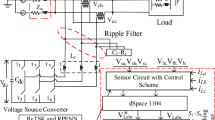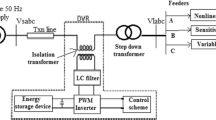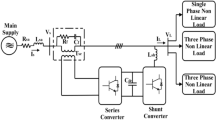Abstract
This paper proposes adaptive voltage control strategies for a three-wire dynamic voltage restorer based on a self-adaptive fuzzy neural network for estimation of fundamental weight components and optimal extreme learning machine control for smooth voltage regulation. The SAFNN overcomes the sequential tuning process of classical ANFIS controllers by simultaneously optimizing the structure and parameters of unknown system dynamics. The construction of SAFNN does not require control base rules in the initial phase and this enhances the learning capability to track the approximated voltage error. The proposed SAFNN employs the linear transformation of the input signal to optimize the required fuzzy rules and speed up the online learning process to achieve the higher accuracy of the control results. The meta-algorithms whale optimization algorithm and Harris hawks optimization is employed for online dynamic behavior identification. The SAFNN-WOA optimizes the membership function to estimate direct and quadrature axis voltage for prediction performance in terms of fast-tracking predefined signals, fewer oscillations, and voltage compensation ability. The dc-link voltage is accurately estimated by employing OELM-HHO and provides improved power quality performance during voltage disturbances. The OELM has the inherent feature of randomly generating the initial weights which effectively evaluates the output weight during the online training procedure and enhances the learning rate. The statistical tools MSE, RMSE, ME, SD, and R during the training stage were evaluated as 168.9052, 12.9964, − 5.5524e−07, 12.9965 and during the testing stage the value are 168.9611, 12.9985, − 0.11566, 12.9986 and 0.78654. These statistical assessment values confirm the goodness-of-fit of the predictive model. The result shows that the proposed hybrid controls SAFNN-WOA and OELM-HHO-based DVR significantly achieves the prediction accuracy for both training and test dataset. Nevertheless, the proposed intelligent DVR model outperforms the other state-of-the-art methods.















Similar content being viewed by others
Abbreviations
- DVR:
-
Dynamic voltage restorer
- SAFNN:
-
Self-adaptive fuzzy neural network
- OELM:
-
Optimal extreme learning machine
- ELM:
-
Extreme learning machine
- ANFIS:
-
Adaptive neuro-fuzzy inference system
- WOA:
-
Whale optimization algorithm
- HHO:
-
Harris hawks optimization
- MFs:
-
Membership function
- MSE:
-
Mean square error
- RMSE:
-
Root mean square error
- ME:
-
Mean error
- SD:
-
Standard deviation
- R:
-
Coefficient of correlation
- PQ:
-
Power quality
- PI:
-
Proportional integral
- FNNs:
-
Fuzzy and neural networks
- PCC:
-
Point of common coupling
- VSC:
-
Voltage source converter
- FIS:
-
Fuzzy inference system
- NN:
-
Neural network
- SOFC:
-
Self-organizing fuzzy controller
- AFC:
-
Enhanced adaptive fuzzy control
- FAE:
-
Fuzzy approximation error
References
Roncero-Sánchez, P., Acha, E., Ortega Calderon, J.E., Batlle, V.F., Garcia Cerrada, A.: A versatile control scheme for a dynamic voltage restorer for power-quality improvement. IEEE Trans. Power Delivery 24(1), 277–284 (2009)
Khooban, M.H., Javidan, R.: A novel control strategy for DVR: optimal bi-objective structure emotional learning. Int. J. Electr. Power Energy Syst. 83, 259–269 (2016)
Benachaiba, C., Mazari, B., Tandjaoui, M.N., Haidar, A.M.: Power quality enhancement using DVR based on ant colony controller. International Scientific Conference on Power and Electrical Engineering RTUCON 2016, 3–6 (2016)
Kinhal, V.G., Agarwal, P., Gupta, H.O., Member, S.: Performance Investigation of neural network based unified power-quality conditioner. IEEE Trans. Power Delivery 26(1), 431–437 (2011)
D. Committee, I. Power and E. Society, IEEE Recommended Practice and Requirements for Harmonic Control in Electric Power Systems. In: IEEE Std 519-2014 (Revision of IEEE Std 519-1992), pp.1–29, 11 June 2014. https://doi.org/10.1109/IEEESTD.2014.6826459 (2014)
Babaei, E., Kangarlu, M.F.: Sensitive load voltage compensation against voltage sags/swells and harmonics in the grid voltage and limit downstream fault currents using DVR. J. Electr. Power Syst. Res. 83(1), 80–90 (2012)
Rauf, A.M., Khadkikar, V.: An enhanced voltage sag compensation scheme for dynamic voltage restorer. IEEE Trans. Industr. Electron. 62(5), 2683–2692 (2015)
Rao, U.K., Mishra, M.K., Ghosh, A.: Control strategies for load compensation using instantaneous symmetrical component theory under different supply voltages. IEEE Trans. Power Delivery 23(4), 2310–2317 (2008)
Singh, B., Arya, S.R., Chandra, A., Al-Haddad, K.: Implementation of adaptive filter in distribution static compensator. IEEE Trans. Ind. Appl. 50(5), 3026–3036 (2014)
Wang, Q., Wu, N., Wang, Z.: A neuron adaptive detecting approach of harmonic current for APF and its realization of analog circuit. IEEE Trans. Instrum. Measur. 50(1), 77–84 (2001)
Badoni, M., Singh, A., Singh, B.: Comparative performance of wiener filter and adaptive least mean square-based control for power quality improvement. IEEE Trans. Ind. Electron. 63(5), 3028–3037 (2016)
Fernandes, D.A., Costa, F.F., Martins, J.R.S., Lock, A.S., Da Silva, E.R.C., Vitorino, M.A.: Sensitive load voltage compensation performed by a suitable control method. IEEE Trans. Ind. Appl. 53(5), 4877–4885 (2017)
Raviraj, V.S.C., Sen, P.C.: Comparative study of proportional-integral, sliding mode, and fuzzy logic controllers for power converters. IEEE Trans. Ind. Appl. 33(2), 518–524 (1997)
Padula, F., Visioli, A.: Tuning rules for optimal PID and fractional-order PID controllers. J. Process Control 21(1), 69–81 (2011)
Kakkar, S., Ahuja, R.K., Maity, T.: Performance enhancement of grid-interfaced inverter using intelligent controller. J. Meas. Control 53(3–4), 551–563 (2020)
Ebrahim, M.A., Talat, B., Saied, E.M.: Implementation of self-adaptive Harris Hawks Optimization-based energy management scheme of fuel cell-based electric power system. Int. J. Hydrogen Energy, pp 1–20 (2021)
Dhiman, G., Kumar, V.: Spotted hyena optimizer: A novel bio-inspired based metaheuristic technique for engineering applications. J. Adv. Eng. Softw. 114, 48–70 (2017)
Dinkar, S.K., Deep, K.: Opposition based laplacian ant lion optimizer. J. Comput. Sci. 23, 71–90 (2017)
El Aziz, M.A., Ewees, A.A., Hassanien, A.E.: Whale optimization algorithm and Moth-Flame Optimization for multilevel thresholding image segmentation. J. Expert Syst. Appl. 83, 242–256 (2017)
Xu, Y., Dong, Z.Y., Meng, K., Zhang, R., Wong, K.P.: Real-time transient stability assessment model using extreme learning machine. J. IET Gener. Trans. Distrib. 5(3), 314–322 (2011)
Lin, F.J., Lin, C.H., Shen, P.H.: Self-constructing fuzzy neural network speed controller for permanent-magnet synchronous motor drive. IEEE Trans. Fuzzy Syst. 9(5), 751–759 (2001)
Wang, N., Joo Er, M.: Self-Constructing adaptive robust fuzzy neural tracking control of surface vehicles with uncertainties and unknown disturbances. IEEE Trans. Control Syst. Technol. 23, 991–1002 (2015)
Lian, R.: Adaptive self-organizing fuzzy sliding-mode radial basis-function neural-network controller for robotic systems. IEEE Trans. Industr. Electron. 61(3), 1493–1503 (2014)
Nabipour, M., Razaz, M., Seifossadat, S.G.H., Mortazavi, S.S.: A novel adaptive fuzzy membership function tuning algorithm for robust control of a PV-based dynamic voltage restorer (DVR). J. Eng. Appl. Artif. Intell. 53, 155–175 (2016)
Pan, Y., Er, M.J.: Enhanced adaptive fuzzy control with optimal approximation error convergence. IEEE Trans. Fuzzy Syst. 21(6), 1123–1132 (2013)
Wang, J., Lu, S., Wang, S., Zhang, Y.: A review on extreme learning machine. J. Multimedia Tools Appl. (2021)
Liang, L., Duan, Z., Li, G., Zhu, H., Shi, Y., Cui, Q., Chen, B., Wensen, Hu.: Status evaluation method for arrays in large-scale photovoltaic power stations based on extreme learning machine and k-means. J. Energy Rep. 7, 2484–2492 (2021)
Teo, T.T., Logenthiran, T., Woo, W.L.: Forecasting of photovoltaic power using extreme learning machine. In: Proceedings of IEEE innovative smart grid technologies- Asia (ISGT ASIA), pp 1–6 (2015)
Prasad, T.V., Lakra S., Ramakrishna, G.: Applicability of crisp and fuzzy logic in intelligent response generation. In: Proceedings of national conference on information, computational technologies and e-governance, pp. 137–139. Alwar, Rajasthan (2010)
Kambalimath, S., Deka, P.C.: A basic review of fuzzy logic applications in hydrology and water resources. J. Appl. Water Sci. 10, 191 (2020)
Funding
Under Science and Engineering Research Board-New Delhi Project (Extra Mural Research Funding Scheme), Grant No.SB/S3/EECE/030/2016, Dated 17/08/2016.
Author information
Authors and Affiliations
Contributions
The author contributed to the research design, results in the evaluation and elaboration of the manuscript. The main contribution is that the proposed SAFNN model is integrated with WOA to build an online fuzzy inference system that automatically extracts the fuzzy rules for the estimation of the fundamental component under non-ideal grid voltage. The OELM based on the HHO controller is implemented for the fast estimation and mitigation of harmonics in the distribution system. Solution techniques are proposed to enhance its performance based on the intelligent control scheme for fast-tracking the reference signal and reducing the complexity of the control system. The intelligent DVR control scheme shows excellent under dynamic operation at different load conditions.
Corresponding author
Ethics declarations
Conflict of interest
The authors declare that they have no conflict of interest to publish this paper.
Appendices
Appendix 1
AC mains: 415 V (L-L), 50 Hz; Rs = 0.01 Ω, Ls = 2 mH; load current (iL) = 21A; Ripple filters Rf = 6Ω, Cf = 10 μF; Interfacing inductor Lf = 1.3 mH; DC bus capacitor Cdc = 3300 μF; DC bus voltage Vdc = 300 V; AC bus voltage (Vt) = 339 V; load: 18 kVA (0.8 p.f. lagg.), sample time (ts) = 20 µs.
Appendix 2: Parameters Setting for Optimization Algorithm
Main three common control Parameters includes Number of search agents: 30 and Max number of iterations = 1000. WOA and HHO Training samples: 8000 dataset, Testing samples: 2000 dataset. Training Algorithm: WOA, a = [0,2], b = [− 1,1], Membership Function (Gaussian Type): Clusters = 15 and Number of fuzzy rules = 15.
Rights and permissions
About this article
Cite this article
Kumar, P., Arya, S.R. & Mistry, K.D. Performance Enhancement of DVR Using Adaptive Neural Fuzzy and Extreme Learning Machine-Based Control Strategy. Int. J. Fuzzy Syst. 24, 3416–3430 (2022). https://doi.org/10.1007/s40815-022-01265-4
Received:
Revised:
Accepted:
Published:
Issue Date:
DOI: https://doi.org/10.1007/s40815-022-01265-4




